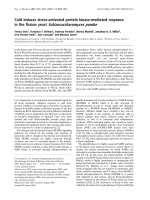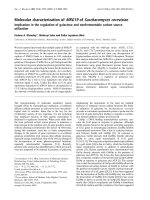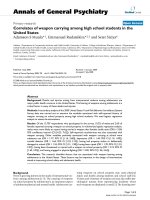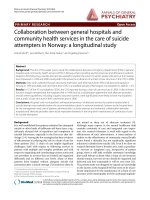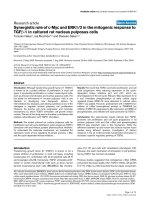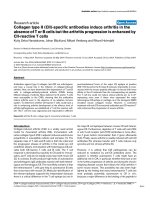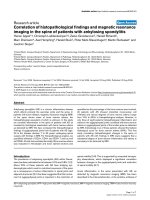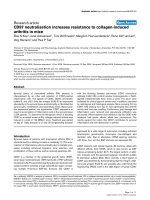Báo cáo y học: "An artificial intelligence tool to predict fluid requirement in the intensive care unit: a proof-of-concept study" docx
Bạn đang xem bản rút gọn của tài liệu. Xem và tải ngay bản đầy đủ của tài liệu tại đây (413.47 KB, 7 trang )
Open Access
Available online />Page 1 of 7
(page number not for citation purposes)
Vol 12 No 6
Research
An artificial intelligence tool to predict fluid requirement in the
intensive care unit: a proof-of-concept study
Leo Anthony Celi
1
, L Christian Hinske
2
, Gil Alterovitz
3
and Peter Szolovits
4
1
Laboratory of Computer Science, Massachusetts General Hospital, 50 Staniford Street, 7th floor, Boston, MA 02114, USA
2
Decision Systems Group, 900 Commonwealth Avenue, 3rd Floor, Boston, MA 02215, USA
3
Children's Hospital Informatics Program, Enders Building 6th Floor, room 624.1, 320 Longwood Avenue, Boston, MA 02115, USA
4
The Stata Center, Building 32, 32 Vassar Street, Cambridge, MA 02139, USA
Corresponding author: Leo Anthony Celi,
Received: 25 Aug 2008 Revisions requested: 15 Oct 2008 Revisions received: 31 Oct 2008 Accepted: 1 Dec 2008 Published: 1 Dec 2008
Critical Care 2008, 12:R151 (doi:10.1186/cc7140)
This article is online at: />© 2008 Celi et al.; licensee BioMed Central Ltd.
This is an open access article distributed under the terms of the Creative Commons Attribution License ( />),
which permits unrestricted use, distribution, and reproduction in any medium, provided the original work is properly cited.
Abstract
Introduction The goal of personalised medicine in the intensive
care unit (ICU) is to predict which diagnostic tests, monitoring
interventions and treatments translate to improved outcomes
given the variation between patients. Unfortunately, processes
such as gene transcription and drug metabolism are dynamic in
the critically ill; that is, information obtained during static non-
diseased conditions may have limited applicability. We propose
an alternative way of personalising medicine in the ICU on a real-
time basis using information derived from the application of
artificial intelligence on a high-resolution database. Calculation
of maintenance fluid requirement at the height of systemic
inflammatory response was selected to investigate the feasibility
of this approach.
Methods The Multi-parameter Intelligent Monitoring for
Intensive Care II (MIMIC II) is a database of patients admitted to
the Beth Israel Deaconess Medical Center ICU in Boston.
Patients who were on vasopressors for more than six hours
during the first 24 hours of admission were identified from the
database. Demographic and physiological variables that might
affect fluid requirement or reflect the intravascular volume during
the first 24 hours in the ICU were extracted from the database.
The outcome to be predicted is the total amount of fluid given
during the second 24 hours in the ICU, including all the fluid
boluses administered.
Results We represented the variables by learning a Bayesian
network from the underlying data. Using 10-fold cross-validation
repeated 100 times, the accuracy of the model in predicting the
outcome is 77.8%. The network generated has a threshold
Bayes factor of seven representing the posterior probability of
the model given the observed data. This Bayes factor translates
into p < 0.05 assuming a Gaussian distribution of the variables.
Conclusions Based on the model, the probability that a patient
would require a certain range of fluid on day two can be
predicted. In the presence of a larger database, analysis may be
limited to patients with identical clinical presentation,
demographic factors, co-morbidities, current physiological data
and those who did not develop complications as a result of fluid
administration. By better predicting maintenance fluid
requirements based on the previous day's physiological
variables, one might be able to prevent hypotensive episodes
requiring fluid boluses during the course of the following day.
Introduction
The gold standard in evidence-based medicine is a well-
designed, well-executed multi-centre prospective randomised
controlled trial. However, in the intensive care unit (ICU), it
would be impossible to perform such a study to determine
whether every diagnostic test, monitoring device or treatment
intervention leads to improved patient outcomes. Even when
such trials are performed and subsequently published, they
rarely, if ever, provide clear evidence on which to base the
management of an individual patient.
Patients enrolled in these studies are heterogeneous, and con-
clusions are valid for the 'average' patient. Unfortunately, each
patient is unique in terms of how he responds to an interven-
tion. He may not benefit or, worse, may be harmed by a medi-
cation, device or procedure that has been shown to correlate
with a good patient outcome 'on average'. In addition, these
ICU: intensive care unit; MIMIC: Multi-parameter Intelligent Monitoring for Intensive Care.
Critical Care Vol 12 No 6 Celi et al.
Page 2 of 7
(page number not for citation purposes)
studies investigate one treatment at a time. In reality, treat-
ments are given simultaneously to a patient in the ICU and
interact with each other. The nature of these interactions is
likely to vary from patient to patient, and perhaps even within
the same patient at different points in time.
Over the years, we have adopted a multitude of diagnostic
tests, monitoring devices and treatments in the ICU based on
underpowered studies, in most cases non-randomised, which
demonstrate modest benefits on soft clinical endpoints or
intermediate outcomes. It is unclear which of these interven-
tions contribute to survival benefit. Despite all the medical
advances available in the ICU, less than half of patients who
experience severe sepsis are alive one year later [1]. Another
study found that mortality of pneumococcal bacteraemia has
not changed over the past 50 years [2]. Finally, acute renal fail-
ure treated in the ICU with renal support therapy still carries a
mortality of 64% to 79%, which has not significantly changed
over the decades [3].
Over the past decade, we have witnessed the electronification
of health care delivery and with it, the creation of large ICU
databases of tremendous granularity and resolution. At the
same time, the concept of personalised medicine emerged.
The goal of personalised medicine is to provide the right treat-
ment to the right patient at the right time. It involves the inte-
gration of genomics, proteomics, metabolomics, systems
biology, bioimaging and other disciplines in order to character-
ise the uniqueness of a patient and predict his risk of develop-
ing a disease or his response to treatment. It is a tool that can
potentially optimise care customisation in the ICU where it is
needed the most, given how sick the patients are and how
some treatments can lead to worse clinical outcomes. Unfor-
tunately, the dynamic cytokine and neurohormonal milieu of
the critically ill patient alters such processes as gene transcrip-
tion and drug metabolism, rendering information derived dur-
ing static non-diseased conditions of limited use. In this paper,
we propose an alternative way of personalising medicine in the
ICU using empiric data to build patient-specific and clinical
scenario-specific models. We chose the prediction of fluid
requirement of the critically-ill patient at the height of inflamma-
tory response to explore the feasibility of this approach.
The first 72 hours after admission are critical for ICU patients.
Whether the patient is being admitted for sepsis, acute coro-
nary syndrome, multiple traumatic injuries, intracranial haemor-
rhage, burns or post-operative care after open heart surgery or
organ transplantation, this period is characterised by systemic
inflammatory responses fueled by a cytokine storm and the
patient is most vulnerable to episodes of hypotension and con-
sequently reduced organ perfusion. Suboptimal fluid manage-
ment during this critical period leads to the release of more
inflammatory cytokines and catecholamines that further
worsen the haemodynamic status of the patient. As shown in
a number of clinical studies, reduced tissue perfusion resulting
from fluid under-resuscitation translates into increased illness
severity and a longer ICU stay [4,5]. In practice, clinicians esti-
mate the rate of maintenance fluids (usually in the range of 1
to 3 ml/kg/hour) by estimating fluid loss, a task that is very dif-
ficult in a critically ill patient because of the absence of a
defined set of rules and guidelines for specific patient subsets
in various clinical scenarios. In this study, we set out to see if
we could predict the total amount of fluid administered to a
patient on day two in the ICU, given the physiological data
from the previous 24 hours.
Materials and methods
The Laboratory of Computational Physiology at Massachu-
setts Institute of Technology developed and maintains the
Multi-parameter Intelligent Monitoring for Intensive Care
(MIMIC II) database, a high-resolution database of ICU
patients admitted to the Beth Israel Deaconess Medical
Center in Boston since 2003, who have been de-identified by
removal of all protected health information. An Institutional
Review Board approval was obtained from both Massachu-
setts Institute of Technology and Beth Israel Deaconess Med-
ical Center for the development, maintenance and public use
of a de-identified ICU database.
The MIMIC II database currently consists of data from more
than 18,000 patients that have been de-identified and format-
ted to facilitate data-mining. The three sources of data are
waveform data collected from the bedside monitors, hospital
information systems and other third-party clinical information
systems.
Using the MIMIC II database, we identified patients who were
on vasopressor agents for more than six hours during the first
24 hours of their ICU admission. For each patient, we obtained
demographic data and physiological variables during the first
24-hour period in the ICU. These variables included vital signs,
those that affect and/or represent total body water, and those
that reflect severity of illness (Table 1). Rather than represent-
ing one state of each variable, which is typically the worst value
in severity scoring systems, we decided to include the follow-
ing for each variable that we evaluated: mean, variance, maxi-
mum value, minimum value, number of measurements
obtained and the last measurement taken during the first 24
hours, as this reflects whether the patient is improving, stablis-
ing or worsening compared with the worst value. Filtering was
performed by deleting values that were outside the physiolog-
ically feasible range.
Using R software (R version 2.7.2, The R Foundation for Sta-
tistical Computing, Auckland, New Zealand), linear regression
was performed using stepwise forward variable selection and
with a 2:1 split sample approach (2/3 training data, 1/3 valida-
tion data). The total fluid administered during the second 24-
hour period in the ICU was selected as the outcome variable.
Using Bayesware Discoverer (Bayesware Discoverer Version
Available online />Page 3 of 7
(page number not for citation purposes)
1.0, Massachusetts Institute of Technology, Cambridge, MA,
USA), we also constructed a Bayesian network using the var-
iables identified and extracted from the MIMIC II database. A
Bayesian network is generated depicting the relation between
variables based on the joint conditional probability distribu-
tions of the variables from the data set. The output is a graph-
ical model representing the variables and their probabilistic
dependencies. For our model generation, a maximum number
of allowable parents was set at 10, and the threshold Bayes
factor was set at 7. The variables, including the outcome vari-
able, were divided at quartiles according to frequency.
Finally, the search order was arranged so that the outcome
variable we are interested in, that is the total fluid intake for the
second 24 hours after ICU admission, would have the largest
number of nodes considered as potential parents. The accu-
racy of the model in predicting the outcome is calculated using
10-fold cross validation repeated 100 times.
Results
There were a total of 3014 patients who were on at least one
vasopressor agent for a minimum period of six hours during
their first 24 hours in the ICU and whose total fluid intake and
output were recorded.
The distribution of the total fluid intake during the second day
in the ICU, the outcome variable, was skewed towards the
lower values (Figure 1). The values were therefore log trans-
formed to approximate a more normal distribution for the linear
regression model.
Using a stepwise forward variable selection on a 2:1 split sam-
ple approach, 14 variables were found to be predictive of the
total amount of fluid given to the patient on day two in the ICU.
The coefficients of the variables in the fitted model, their stand-
ard errors and the corresponding p values are shown in Table
2.
Table 1
Patient variables evaluated as possible predictors of maintenance fluid requirement.
General demographics Age
Sex
Weight
Physiological variables Blood pressure
Heart rate
Variables that affect and/or represent total body water Total fluid input during the first 24 hours
Total fluid output during the first 24 hours
Serum creatinine, as a surrogate marker of kidney function
Serum sodium
Variables that affect insensible fluid loss Body surface area
Temperature
Variables that reflect severity of illness Serum albumin
Serum lactate
Maximum number of vasopressors and inotropes
Maximum number of sedatives and narcotic agents
Serum bilirubin
Haemoglobin
Platelet count
PaO
2
:FiO
2
ratio
FiO
2
= fraction of inspired oxygen; PaO
2
= partial pressure of oxygen in arterial blood.
Critical Care Vol 12 No 6 Celi et al.
Page 4 of 7
(page number not for citation purposes)
R-squared was calculated as a measure of the explained vari-
ation accounted for by the linear regression model. It is given
by the formula:
R
2
= 1 - (SS
err
/SS
tot
)
where SS
err
is the residual sum of squares and SS
tot
is the sum
of squares differences from the mean proportional to the vari-
ance. The adjusted R-squared value calculated was 0.25, sug-
gesting that very little of the observed variation can actually be
explained by the model. The linear regression model suffered
from large variation with a high standard residual error, making
it suboptimal for clinical application. For this reason, we shifted
to a Bayesian network model to represent our variables and
outcome.
Figure 2 illustrates the Bayesian network model generated
from the MIMIC II database. For this particular data set, five
variables were found to be correlated with the total fluid intake
for the second 24 hours in the ICU: total fluid intake for the first
24 hours, number of vasopressor agents, mean systolic pres-
sure, mean heart rate and mean serum sodium. Based on the
model, the probability that a patient will require a certain range
of fluid on day two can be predicted given the values of the var-
iables that are direct parents of our outcome variable. The
accuracy of the model in predicting the outcome variable was
found to 77.8% on 10-fold cross validation repeated 100
times. This means the model generated from the training set,
when applied to the validation set, was able to accurately pre-
Figure 1
Distribution of total fluid intake on day twoDistribution of total fluid intake on day two.
Table 2
Coefficients of the fitted linear regression model.
Variables Estimate Standard error p value
Number of vasopressors 5.35e+02 2.38e+03 3.25e-06
Maximum heart rate (beats per minute) 1.12e+01 3.65 6.43e-09
Maximum haemoglobin (mg/L) 5.71e+01 8.76e+01 0.0021
Minimum haemoglobin (mg/L) -5.17e+02 9.36e+01 1.03e-10
Variance of haemoglobin (mg/L) -1.92e+02 4.72e+01 4.01e-08
Total fluid intake on day 1 (ml) 1.03e-01 2.14e-02 5.09e-05
Total fluid output on day 1 (ml) -1.99e-01 3.68e-02 1.50e-06
Most recent platelet count (×10
9
/L) 1.19e+01 2.99 7.90e-08
Number of sedatives 2.74e+02 1.07e+02 7.73e-05
Age (years) -1.15e+01 4.68 0.0106
Mean platelet count (×10
9
/L) 1.37e+01 2.97 4.17e-06
Minimum serum sodium (mEq/L) 1.68e+02 4.21e+01 7.27e-05
Most recent serum sodium (mEq/L) 8.33e+01 3.61+01 0.0212
Mean serum sodium (mEq/L) 1.67e+02 6.29e+01 0.0080
Available online />Page 5 of 7
(page number not for citation purposes)
dict the quartile of the total fluid administered on day two in
77.8% of cases.
The threshold Bayes factor is the smallest amount of evidence
that can be claimed for the null hypothesis (no correlation
between variables) or the strongest evidence against it on the
basis of the observed data. This is the benchmark to compare
it against a p value. The simplest relation between p values and
Bayes factors are based on a Gaussian approximation. In that
situation, the Bayes factor is calculated with the same num-
bers used to calculate a p value [6]. The formula is as follows:
[7]
Bayes factor = e
-Z^2/2
where Z is the number of standard errors from the null effect.
This formula allows us to establish an exchange rate between
the Bayes factor and p values in a Gaussian case. For a thresh-
old Bayes factor of seven which was used to generate our
model, the corresponding maximum p value is 0.05, assuming
Gaussian distribution of the variables. Each link between two
nodes in the network has a corresponding Bayes factor. These
were not shown because prediction of a variable based on the
values of the variables it is related to rests solely on the joint
conditional probability distribution and not on the individual
Bayes factors.
Discussion
Figuring out the fluid requirement to maintain an adequate
intravascular volume (and optimal preload) is difficult at the
time of critical illness. In practice, clinicians fear over-estimat-
ing this fluid requirement. This may contribute to the occur-
rence of hypotensive episodes especially during the period of
maximal systemic inflammatory response. These hypotensive
episodes may be averted by being able to predict more accu-
rately the fluid requirement of the patient as the disease proc-
ess evolves in response to treatment or as a result of healing.
The goal of this proof-of-concept study is to explore the feasi-
bility of supplementing traditional evidence-based medicine,
expert opinion and clinical intuition with information from
empiric data. A Bayesian network was generated between
physiological variables obtained during the first 24 hours in the
ICU and the total amount of fluid given on the second day in
the ICU (maintenance fluid plus all the boluses the patients
received) from a large database. A greedy search algorithm
was used with the outcome variable of interest being evalu-
ated first for potential parent nodes, and the demographic var-
iables (age, sex and weight) being evaluated last. Given the
values of the physiological variables from day one, the range of
the total fluid given to the patient on day two can be predicted.
Cross-validation was used to determine how well a Bayesian
network model represents our data. In cross-validation, the
model generated from the training set is evaluated against a
Figure 2
Bayesian network model predicting maintenance fluid requirement on day two in the ICUBayesian network model predicting maintenance fluid requirement on day two in the ICU. DBP = diastolic blood presure; Hb = haemoglobin;
Max = maximum; Min = minimum; SBP = systolic blood pressure; Temp = temperature.
Critical Care Vol 12 No 6 Celi et al.
Page 6 of 7
(page number not for citation purposes)
previously unseen data. The accuracy of the model in predict-
ing the outcome was 77.8%.
We suspect the reason why the accuracy of the Bayesian net-
work generated from the data is not better may relate to the
limitations of our methodology. The subset of patients
included in the analysis is likely to still represent a heterogene-
ous group given that the reason why the patient was on
vasoactive drugs was not considered. The patients likewise
probably represent a wide spectrum as regards the degree of
inflammatory response, with possible inclusion of patients who
have a minimal amount of inflammation but were put on vaso-
pressors nonetheless. What we would like to do in the future,
when we have a larger database, is to specify a more homoge-
neous group of patients in terms of demographic variables, co-
morbidities and clinical scenario.
Another potential source of model inaccuracy in the ICU is
data noise. This includes device-related artifacts (e.g. arterial
blood pressure dampening), laboratory errors, missing data
and erroneous transcription, to name just a few. Filtering dur-
ing data pre-processing was performed to reduce, but not
obliterate, the impact of noise. The choice of the threshold
Bayes factor (the likelihood of the model with links between
the parent nodes and their children as compared with a model
where the variables are independent) is thus crucial in prevent-
ing over-fitting when the data is unavoidably noisy.
A point of contention is whether to include clinical outcomes
(e.g. resolution of acidosis, discontinuation of vasoactive
agents, ICU length of stay or mortality) in the generation of the
model. We elected to exclude these variables from the model
generation because there are other variables that affect these
clinical outcomes apart from fluid management (e.g. choice of
antibiotics and timeliness of surgery if required). For this proof-
of-concept study, we took a simple approach and focused on
predicting how much fluid is given to a patient depending on
physiological data obtained during the previous 24 hours,
regardless of clinical outcome.
A number of studies have looked at the application of artificial
intelligence tools in the ICU. Barbini and colleagues [8] and
Cevenini and colleagues [9] compared different models in pre-
dicting ICU morbidity after cardiac surgery and found the
Bayesian and logistic regression models to be superior to arti-
ficial neural network, scoring systems and k-nearest neighbour
in terms of discrimination, generalisation and calibration for
this particular task. Bayesian network has also been used to
predict prognosis of head injured patients in the ICU [10],
mortality of patients readmitted to the ICU [11] and likelihood
of ventilator-associated pneumonia [12] and other nosocomial
infections [13].
It is unlikely that we can replace clinician expertise with an
intelligent software. We envision three important uses of artifi-
cial intelligence tools applied to empiric data. The first is to
supplement clinical knowledge to support decisions in spe-
cialised, complicated problems where there may not be ade-
quate evidence in the way of prospective randomised
controlled trials. Figure 3 represents a diagram of how we
envision the incorporation of this approach into clinical prac-
tice. The second is to potentially accelerate acquisition of clin-
ical intuition by junior doctors in the ICU by 'learning' from their
local database how senior intensivists managed identical
patients in a specific clinical scenario. Finally, these tools
might be of use for ongoing surveillance of medical devices,
medications and interventions for clinical outcomes (rather
than surrogate endpoints) especially in the ICU where these
are sometimes adopted without clear evidence of long-term
benefit.
We have taken a deductive approach in generating a model
from empiric data. Combining such a deductive approach with
an inductive knowledge base from domain expertise in patho-
logical physiological processes and available ICU literature
may provide a better tool in assisting clinicians in making deci-
sions for individual patients in specific clinical scenarios.
Conclusion
There are very few interventions performed in the ICU, whether
for diagnostic, monitoring or treatment purposes, that are
based on robust evidence. Even when prospective ran-
domised controlled trials are available, they rarely, if ever, pro-
vide clear evidence on which to base the management of an
individual patient. This project introduces the concept of using
empiric data to obtain patient-specific and clinical scenario-
specific recommendations in the ICU. Prediction of mainte-
nance fluid is chosen as the problem domain to test the feasi-
bility of the concept. A software application is envisioned that
builds a model consisting of patients that are similar to an
index patient in terms of age, gender, ethnicity, admitting diag-
Figure 3
Artificial intelligence at the point-of-care in the ICUArtificial intelligence at the point-of-care in the ICU.
Available online />Page 7 of 7
(page number not for citation purposes)
nosis, severity score on admission and co-morbidities. Based
on the model, physiological variables that are directly corre-
lated with the outcome variable of interest are identified. The
idea is to provide the values of these predictor variables from
the index patient to the model, and a predicted range of fluid
requirement is obtained from the joint conditional probabilities.
We plan to evaluate the effect of the availability of this
information in the ICU in an intention-to-treat prospective
observational study. An adherence-to-protocol and on-treat-
ment analyses will be incorporated into the design of the
study.
Competing interests
The authors declare that they have no competing interests.
Authors' contributions
LC conceived of the study under the guidance of PS. LC and
CH performed the data extraction and pre-processing, and
with the help of GA, the data analysis. All authors read and
approved the final manuscript.
Acknowledgements
This work has been supported in part by National Library of Medicine
Training Grant # 2T15LM007092-16. The authors would like to thank
Professor Roger Mark, Mauro Villaroel, Gari Clifford and Li-Wei Lehman
for their assistance in using the MIMIC II database.
References
1. Yende S, Angus D: Long-term outcomes from sepsis. Curr
Infect Dis Rep 2007, 9:382-386.
2. Trampuz A, Widmer AF, Fluckiger U, Haenggi M, Frei R, Zimmerli
W: Changes in the epidemiology of pneumococcal bacteremia
in a Swiss university hospital during a 15-year period, 1986–
2000. Mayo Clin Proc 2004, 79:604-612.
3. Landoni G, Zangrillo A, Franco A, Aletti G, Roberti A, Calabrò MG,
Slaviero G, Bignami E, Marino G: Long-term outcome of patients
who require renal replacement therapy after cardiac surgery.
Eur J Anaesthesiol 2006, 23:17-22.
4. Rivers E, Nguyen B, Havstad S, Ressler J, Muzzin A, Knoblich B,
Peterson E, Tomlanovich M, Early Goal-Directed Therapy Collabo-
rative Group: Early goal-directed therapy in the treatment of
severe sepsis and septic shock. N Engl J Med 2001,
345:1368-1377.
5. Donati A, Loggi S, Preiser JC, Orsetti G, Münch C, Gabbanelli V,
Pelaia P, Pietropaoli P: Goal-directed intraoperative therapy
reduces morbidity and length of hospital stay in high risk sur-
gical patients. Chest 2007, 132:1817-1824.
6. Berger J: Statistical Decision Theory and Bayesian Analysis New
York: Springer-Verlag; 1985.
7. Goodman SN: Toward evidence-based medical statistics. 2:
The Bayes factor. Ann Intern Med 1999, 130:1005-1013.
8. Barbini E, Cevenini G, Scolletta S, biagioli B, Giomarelli P, Barbini
P: A comparative analysis of predictive models of morbidity in
intensive care unit after cardiac surgery – Part I: model
planning. BMC Med Inform Decis Mak 2007, 7:35.
9. Cevenini G, Barbini E, Scolletta S, biagioli B, Giomarelli P, Barbini
P: A comparative analysis of predictive models of morbidity in
intensive care unit after cardiac surgery – Part II: an illustrative
example. BMC Med Inform Decis Mak 2007, 7:36.
10. Nikifordis G, Sakellaropoulos G: Expert system support using
Bayesian belief networks in the prognosis of head-injured
patients of the ICU. Med Inform (Lond) 1998, 23:1-18.
11. Ho K, Knuiman M: Bayesian approach to predict hospital mor-
tality of intensive care readmissions during the same
hospitalisation. Anaesth Intensive Care 2008,
36:38-45.
12. Schurink CA, Visscher S, Lucas PJ, van Leeuwen HJ, Buskens E,
Hoff RG, Hoepelman AI, Bonten MJ: A Bayesian decision-sup-
port system for diagnosing ventilator-associated pneumonia.
Intensive Care Med 2007, 33:1379-1386.
13. Schurink CA, Lucas PJ, Hoepelman IM, Bonten MJ: Computer-
assisted decision support for the diagnosis and treatment of
infectious diseases in intensive care units. Lancet Infect Dis
2005, 5:305-312.
Key messages
• Only a handful of ICU interventions, whether for diag-
nostic, monitoring or treatment purposes, are based on
well-designed, well-executed prospective randomised
controlled trials.
• The project introduces the concept of mining empiric
data using artificial intelligence to obtain patient-spe-
cific and clinical scenario-specific recommendations in
the ICU.
• The idea is to build a model using patients that are simi-
lar to an index case with regards to age, sex, admitting
diagnosis, co-morbidities and severity score.
• Prediction of maintenance fluid requirement in the ICU
was chosen to explore the feasibility of the approach.
• The information obtained from the model may be useful
in supplementing a clinician's knowledge base and
intuition.
